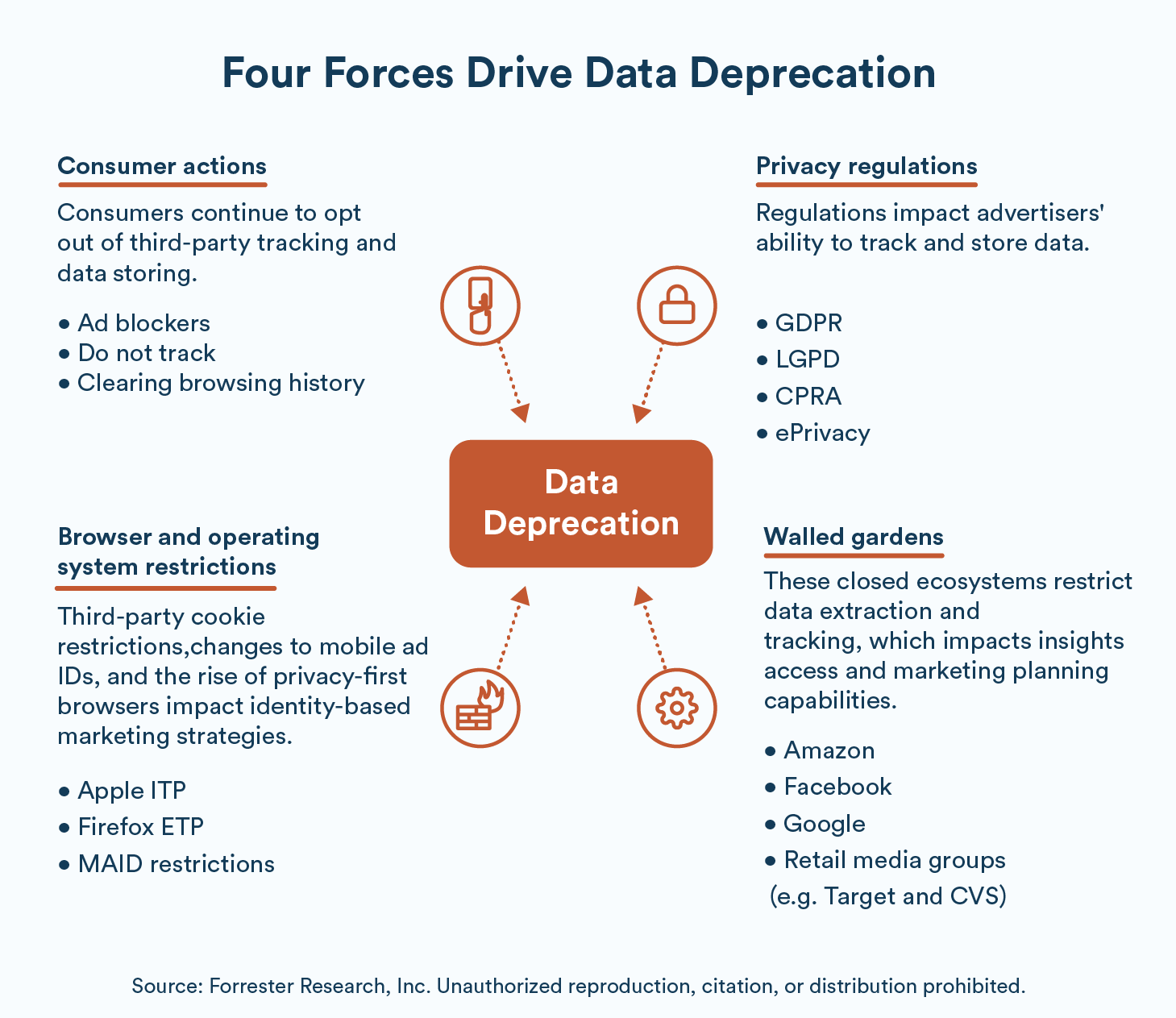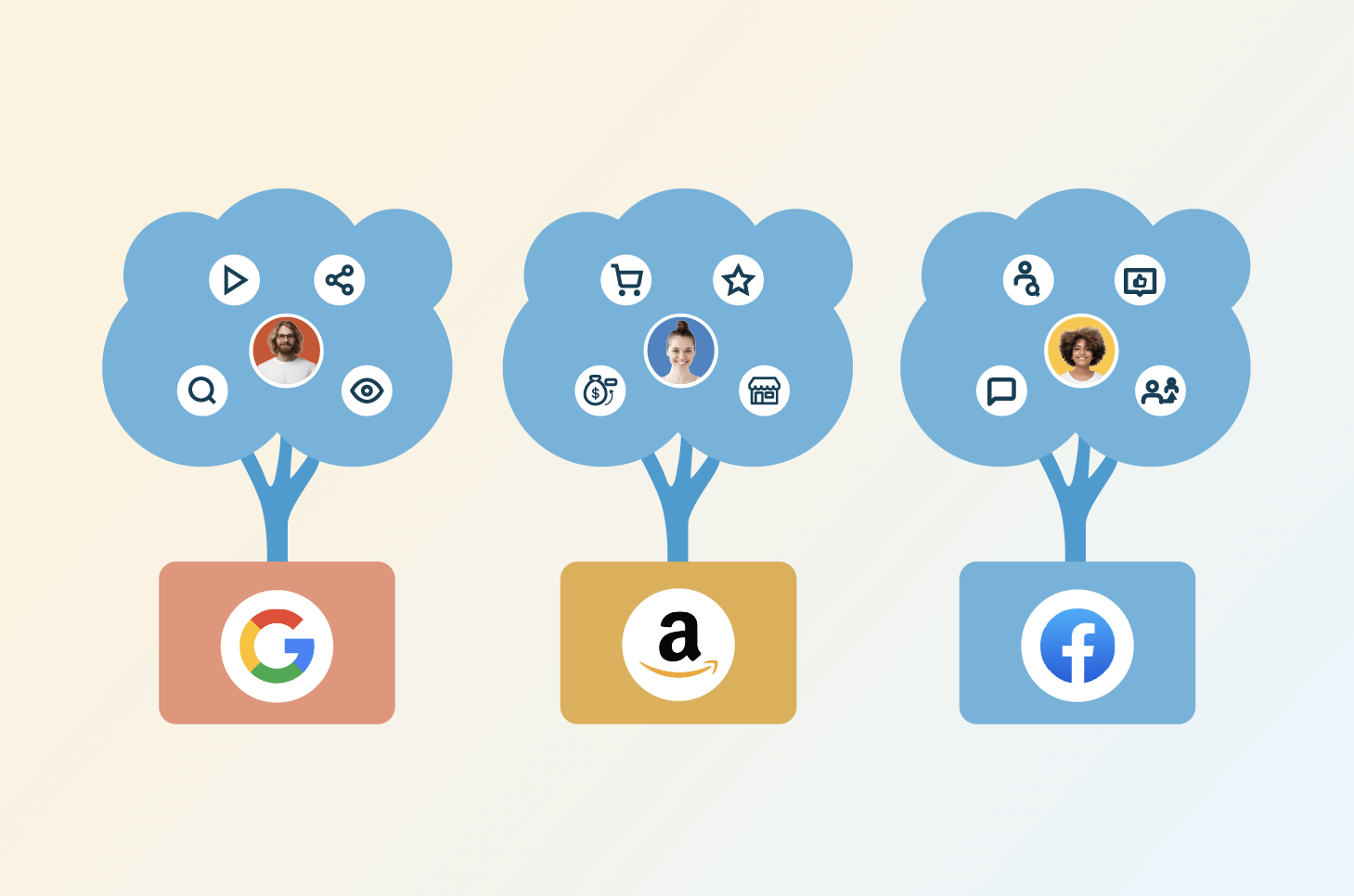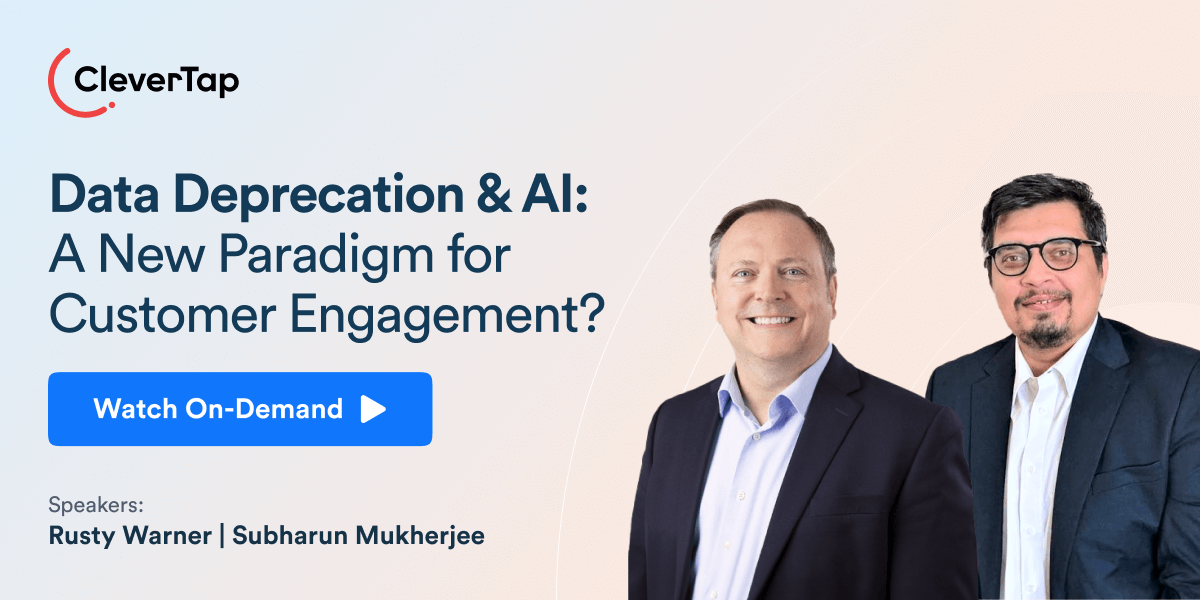Data deprecation refers to how data loses its value and becomes less useful over time. In this blog, learn actionable tactics on how to navigate the evolving privacy regulations and technology that is changing data collection practices.
Data Deprecation— the Elephant in the Room
The generational shift caused by data deprecation has been a harsh wake-up call for advertisers, marketers, and entrepreneurs of direct-to-customers (D2C) and e-commerce companies.
It has compelled them to explore innovative methods for collecting and utilizing customer data. They can no longer freely sift through customers’ personal information, browsing patterns, purchase history, and social media activity without restrictions.
Data deprecation involves removing or limiting access to the deprecated data. Are you prepared to handle the challenges posed by data deprecation? How can you navigate these challenges without any additional cost to your business? Let’s find out in this blog.
What is Data Deprecation?
Data deprecation refers to how data loses its value and becomes less useful over time. Coined by Forrester, data deprecation is the restriction of tracking and access to consumer data due to the loss of cookies, strengthening privacy regulations, walled gardens, and consumer privacy expectations. Data deprecation has become a harsh reality check for data-driven marketing.
“If we think about data deprecation as multi-faceted, we consider it from a third-party cookie perspective, a legislative perspective, and, more importantly, from a customer perspective. We can then begin to change our approach to data collection from first-party data to zero-party data and do so in a way that encourages customers to share data with us.”- Rusty Warner, Vice President and Analyst, Forrester
For example, e-commerce businesses may struggle with less effective targeted advertising and personalized recommendations due to data deprecation, like a clothing retailer losing the ability to recommend specific items based on past browsing behavior.

Four Forces Driving Data Deprecation
Let’s examine more closely the four factors causing data deprecation and prompting advertisers and marketers to rely less on conventional data collection techniques.
1. Consumer Awareness and Expectations Around Privacy
Consumers want to be in control of the personal information they share with companies, be able to browse the web in privacy, and want more control over what companies can and cannot do with their personal information, and how their data is used.
75% of consumers would not make a purchase from a company, including their preferred retailers, if they did not trust them with their data. Companies may also face damage to their brand trust because of negative privacy experiences and a data breach.
Similarly, consumers’ concerns are also highlighted in the KPMG survey:
- 86% say data privacy is a growing concern for them
- 68% are concerned about the level of data being collected by businesses
- 40% don’t trust companies to ethically use their data
- 30% aren’t willing to share their personal data for any reason
2. Privacy Regulations
Governments have enforced stringent laws like the General Data Protection Regulation (GDPR) and the California Consumer Privacy Act (CCPA) to ensure that user data is safe and protected. These laws put the customer in the driver’s seat, and puts the onus on businesses and organizations to abide by them.

3. Browser Restrictions on Cookies, Mobile Ad IDs, and Privacy
While certain cookies are essential for functions such as keeping visitor sessions active, third-party cookies have been contentious due to their capacity to monitor users across the internet without their awareness or consent. These worries about third-party cookies have led to new legislation and prompted major tech companies like Apple, and Mozilla to move away from using them in their browsers.
On July 22, 2024, Google revealed that it will not phase out third-party cookies in Chrome as previously planned. Instead, the company will introduce a new feature that allows users to make informed decisions about their web browsing and adjust their preferences at any time. Despite this shift in policy, the effectiveness and scope of third-party cookies have been steadily declining, and if users are given the choice to opt out of tracking, this could further contribute to the technology becoming obsolete.
4. Walled Gardens

Technology companies are employing walled gardens to gain control over all content and applications on their platforms. The “walled gardens” established by Google, Facebook, Amazon, and large retailers such as Target are impeding cross-channel planning, buying, and optimization by making it more difficult to extract data for use in other channels.
Discover strategies to tackle data deprecation and boost customer engagement for your business. Join Rusty Warner, Vice President and Analyst at Forrester, and Subharun Mukherjee, Head of Marketing at CleverTap, as they share insights in the webinar, Data Deprecation & AI: A New Paradigm for Customer Engagement. Watch now to thrive in a data-driven world.
Impacts of Data Deprecation on Marketing Strategies
How do these four horsemen of data deprecation impact your marketing strategies, and what are the challenges that your business should gear up for?
- Impact on targeting and personalization: It will make it more difficult to tailor personalized offers to individual users due to a lack of browsing and behavioral data. Marketers will find it nearly impossible to comprehend user behavior throughout the full customer journey if cross-site and cross-platform data sharing is severely restricted. For example, a skincare brand will find it difficult to provide personalized product recommendations and targeted marketing campaigns without access to users’ browsing and behavioral data.
- Attribution and measurement challenges: It will be more difficult to gauge the success of advertising and precisely attribute conversions if third-party cookies are removed. It will be far more difficult for brands to compute KPIs like return on ad spend in the absence of third-party data. For example, a D2C company will struggle to accurately measure the effectiveness of their ad campaigns and determine their return on ad spend without third-party cookies to track conversions and attribute sales.
- Data privacy and compliance challenges: With stricter regulations like GDPR and CCPA, businesses have to ensure that their data collection and usage practices comply with privacy laws. For example, in 2021, Zoom Video Communications settled for $85 million following several user privacy complaints, including those involving “Zoombombing.”
- Lack of Resources to invest in alternative solutions: The intricacy of switching from dependence on third-party cookies to other data sources and targeting techniques may pose practical issues for many businesses with limited resources.
Strategies to Counter Data Deprecation
While data deprecation brings its challenges and roadblocks, it also offers brands the golden opportunity to embrace diverse tactics to ethically obtain user data with explicit consent.
Here are three ways that you can prepare your business to make a paradigm shift by seamlessly orchestrating these data collection journeys and also leveraging them in real-time to tailor personalized experiences that resonate with users.
- Zero-party data collection
- Data veils making first-party data consensual, secure & private
- Leveraging existing infra of customer data platform for scaling the collection of zero-party
Let’s take a deeper look into each of the above three solutions.
1. Zero-Party Data Collection
The role of zero-party data is growing in significance as the internet becomes more privacy-centric by the day. Forbes has dubbed zero-party data ‘the new oil’ due to its enormous potential for new forms of personalization. The term ‘zero-party data’ was originally introduced and defined by Forrester as the “data that a customer intentionally and proactively shares with a brand, which can include preference and interests, purchase intentions, personal context, and how the individual wants the brand to recognize them.”
Benefits of Zero-Party Data:
- Trustworthy and accurate: Customers are more likely to be honest about their preferences, behaviors, and true self when they voluntarily give personal information to a company.
- Explicit, not implied: With zero-party data, you are aware of a person’s preferences since they have voluntarily disclosed them to you.
- Leads to better personalization: You can develop more personalized customer experiences that cater to the unique preferences of your customers by orchestrating zero-party data collection journeys.
How to Collect Zero-Party Data:
Employ the following techniques to engage with customers directly and persuade them to willingly disclose personal data:
- Create surveys, polls, and gamification: Create engaging and pertinent surveys, polls, and trivia games for your intended audience.
- Contests and giveaways: Offer incentives, like prizes and contests, to entice customers to share their contact details, preferences, and interests.
- Personalized email campaigns: Send out segmented email marketing to customers according to their interests or preferences.
- Social media engagement: Create polls, quizzes, and surveys on social media sites to provide your consumers engaging experiences while striving to learn about their preferences.
- Customer feedback: Ask for reviews, testimonials, or ratings from customers and provide incentives for their participation.
2. Data Veils Making First-Party Data Consensual, Secure & Private
First-party data, also known as 1P data, refers to information collected directly from individuals who interact with your business. It includes data such as user preferences, purchase history, and interactions with your businesses’ digital properties.
Benefits of First-Party Data:
- Decreased reliance on third-party data: Relying on your own data sources helps you cut down on the use of third-party data, which could provide problems with data quality and compliance.
- Accurate: First-party data guarantees data ownership, accountability, and accuracy—all of which are necessary to abide by data privacy laws.
- Enhanced personalized experience: The fact that first-party data is precise, dependable, and unique to the brand’s consumer interactions, it enables you to orchestrate personalized experience for your customer.
Data in a silo is not useful, but using data across multiple systems has security implications. So then, how do you share data between multiple systems while maintaining regulatory compliance and security and privacy standards?
The answer lies in using data veils! ‘Data veils’ are a layer of security between data origination systems and data processing systems. These veils have varying thickness and porosity that are a function of the organization’s use cases. This enables brands to allow access to only those parts of the customer identity graph that are relevant to the use cases and engagement tactics.
3. Leverage existing infra of customer data platform for scaling the collection of zero-party
As data deprecation becomes a reality, novel solutions of data collection and storage will become necessary. Does this mean brands will now need to invest in additional technologies? Not necessarily.
While many point solutions address zero-party data needs, brands should explore scaling their existing tech investments with their partners.
In fact, businesses can leverage the existing infra of Customer Data Platform (CDP), at no additional cost to collect zero-party data by orchestrating surveys, games contests from existing infra and store that information.
You Might Like to Read: What is Database Marketing? Definition, Examples & Strategies
How is CleverTap Enabling Customers to Navigate Data Deprecation?
In the era of data deprecation, CleverTap is empowering its customers to navigate data deprecation with its ‘all-in-one’ customer engagement platform while also unlocking limitless customer lifetime value.
- Compliance with Privacy Regulations:
- At CleverTap, the security and confidentiality of customer data is dealt with utmost importance.
- As a data processor, CleverTap already takes considerable effort to make sure that the product offering complies with the requirements laid out by the GDPR.
- CleverTap empowers its customers to be GDPR Compliant through ensuring end-user rights, privacy by design, and data breach reporting.
- Right to Access:
- Customers can provide users with access to personal data with CleverTap, allowing them to know how, where, and why their personal data is being processed on their app.
- Customers can create extensive reports on end user profiles using CleverTap’s app publisher on the dashboard, and if required, they can share these with their end users with ease.
- Right to be Forgotten:
- The user has the ability to immediately remove personal data and to revoke consent when they exercise their right to be forgotten, also known as the right to erase.
- In the event that an end user exercises their right to erase, CleverTap’s servers wipe all profile and event data.
- Customers of CleverTap can accomplish this by using an API deletion tool in addition to a dashboard deletion tool. The end user will be considered anonymous if they return to the customer’s app in the future.
- Right to Suppress:
- Similarly, once a user invokes a right to suppress clause (on the app), all data for the user going forward needs to be dropped.
- To allow for this, CleverTap provides its customers with an SDK, which will grant your end users the ability to immediately have their devices stop sending data to CleverTap systems from then on.
- Privacy by Design:
- CleverTap provides complete data transparency to its users.
- CleverTap includes a built-in opt-out option as a default setting so that customers have the necessary user consent before they go ahead with engagement campaigns within the CleverTap platform.
- Data Breach Reporting:
- In order to make it easier for our customers to address data breach notifications promptly, CleverTap has an incident reporting system in place.
- When an incident involving personal data takes place, this system informs our customers of the breach and strongly recommends our customers to communicate the same to their end users.
- First Party Data Collection with Data veils:
- CleverTap facilitates collection of first party data with ‘data veils,’ enabling secure data sharing across systems. ‘Data veils’ are a layer of security between data origination systems and data processing systems.
- These veils have varying thickness and porosity that are a function of the organization’s use cases.
- This enables brands to allow access to only those parts of the customer identity graph that are relevant to the use cases and engagement tactics.
- For instance, a health insurance company incentivizes healthy lifestyles with CleverTap-managed campaigns, leveraging data from activity trackers via a health tracking application.
- Activity data is tracked through the health trackers of their customers and based on this information, the end user receives discounts on their monthly premium.
- The data is first securely and anonymously collected by their health tracking app,
- which then pushes the information to a health data collection platform that collects and securely transfers it for risk assessment
- which then triggers CleverTap driven actions for user engagement.
- Note: CleverTap maintains anonymity, tracking only the channel interactions while ensuring data security.
- Note: This is one of the many use cases of ‘data veils’ where only the requisite data is processed by CleverTap and sensitive data like health and activity information is not passed to the CleverTap systems.
- Scaled for Zero-Party Data and First Party Data Collection:
- CleverTap’s customer data platform (CDP) enables the collection of zero-party data at no additional cost.
- Businesses can easily set up surveys, quizzes, and feedback to directly communicate with customers and understand their preferences for products and services.
- CleverTap’s customer data platform can be easily leveraged to sift through lists of libraries for events and collect first-party data.
Conclusion
Customer data has long been easily accessible to advertisers and marketers without any restrictions. However, in the era of data deprecation, businesses have to adapt to new creative ways to understand and engage with consumers. Access to both first-party and zero-party data is essential as a safeguard against the adverse effects of data deprecation and as a means of achieving ongoing growth. Any queries on how to navigate the complex environment of data deprecation, reach out to CleverTap.
FAQs
What does deprecated mean?
“Deprecated” means a feature or technology is outdated, no longer recommended, and likely to be phased out or replaced.
Is it deprecated or depreciated?
“Deprecated” indicates something is outdated and being phased out, while “depreciated” refers to a decrease in value over time, usually in financial contexts.
What is the data deprecation policy?
A data deprecation policy outlines how and when a company will phase out the use of certain data types or technologies, often due to changes in regulations or industry standards. It ensures that outdated or unsupported data practices are retired systematically and responsibly.
Why is first party data important?
First-party data is crucial because it comes directly from a company’s own customers, providing accurate and relevant insights for personalized marketing and decision-making. It enhances trust and engagement by reflecting direct interactions and relationships.
What is an example of deprecation?
An example of deprecation is the phasing out of Adobe Flash Player, which was gradually discontinued due to security vulnerabilities and the rise of more modern technologies. Another example is older versions of programming languages or APIs that are no longer recommended for use in favor of newer, more efficient versions.
How does data deprecation impact marketing analytics and reporting accuracy?
Data deprecation can impact marketing analytics and reporting accuracy by limiting the availability of historical or third-party data, leading to gaps in insights and potentially less precise performance evaluations. It forces marketers to rely more on first-party data and adapt their strategies to maintain accuracy.
Divya Ojasvi Sharma 
Divya is a communications professional with extensive experience in content writing, content creation and strategies, and social media management.
Free Customer Engagement Guides
Join our newsletter for actionable tips and proven strategies to grow your business and engage your customers.















































